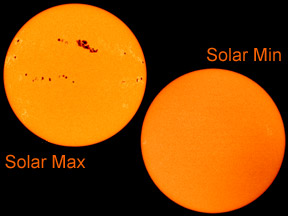The Sunspot Cycle
These two pictures show the Sun and some sunspots. Do you see how the number of sunspots changes? The picture on the left was taken near solar max. It shows many sunspots. The picture on the right was taken near solar min. It doesn't have any sunspots in it at all!
Click on image for full size (62K JPEG)
Windows to the Universe original artwork by Randy Russell.
|
This graph shows the number of sunspots counted each year for many years. Can you see how the number of sunspots changes? Can you see the 11-year sunspot cycle?
Click on image for full size (8K GIF)
Windows to the Universe original artwork by Randy Russell.
|
The number of sunspots seen
on
the Sun changes from year to year. The number of sunspots goes up and down in
a cycle. The length of the cycle is about eleven years on average.
The Sunspot Cycle was discovered in 1843 by Samuel Heinrich Schwabe, a German astronomer.
If you put your finger on the chart to the left, you can follow the Sunpot Cycle. Start low in 1954 and go up and up until around 1959, then start to go down until 1964. Then it's up again. When your finger reaches one of the orange peaks, this is called
"solar maximum" (or "solar
max"). When you come to a valley, it is called "solar
minimum" (or "solar min"). Solar max is where the most sunspots are seen. Solar min is where the lowest number of sunspots are seen.
Look at the chart to see if you were born closest to a solar max or solar min. Solar max is when the Sun is usually very active and there may be more solar
flares and coronal mass ejections. So now you can see if you were born in an active or a quiet time for the Sun!
|
 Sunspots
Sunspots
 The Solar Cycle
The Solar Cycle
 History of Sunspot Observations
History of Sunspot Observations
 Activity: Graphing Sunspot Cycles
Activity: Graphing Sunspot Cycles
 Movie: Magnetic Field Lines Tangle as Sun Rotates
Movie: Magnetic Field Lines Tangle as Sun Rotates
 Movie: Rotating Sun with Sunspots
Movie: Rotating Sun with Sunspots
 Movie: Dark Days Ahead for the Sun (RealVideo courtesy of the National Science Foundation)
Movie: Dark Days Ahead for the Sun (RealVideo courtesy of the National Science Foundation)
 Picture: Solar Corona at Solar Max and Solar Min
Picture: Solar Corona at Solar Max and Solar Min
 Picture: X-ray Image of the Sun at Solar Max and Solar Min
Picture: X-ray Image of the Sun at Solar Max and Solar Min
 Sunspot Jigsaw Puzzle
Sunspot Jigsaw Puzzle
You might also be interested in:

The Sun is not a quiet place, but one that exhibits sudden releases of energy. One of the most frequently observed events are solar flares: sudden, localized, transient increases in brightness that occur
...more
Text for this level has not been written yet. Please see the "Intermediate" text for this page if you want to learn about this topic. To get to the "Intermediate" text, click on the blue "Intermediate"
...more
Have you ever seen an explosion before? Maybe you've seen a volcano explode on t.v. Or maybe you've seen a potato explode in the microwave because your mom forgot to poke holes in it. Well, explosions
...more
Humans have looked for and written down information about sunspots for a very long time! In fact, the first time someone wrote down sunspot information was almost 3,000 years ago in China! An English monk
...more
You know that there are all kinds of storms here on Earth - thunderstorms, blizzards, tornadoes, and hurricanes. The Sunalso has storms. There are two different kinds of storms on the Sun. They are called
...more
Space weather is a new science. It hasn't been studied for thousands of years. So space weather has many questions that still need to be answered. And it has a lot of unsolved mysteries which is exciting!
...more
At first, the temperature gets warmer very quickly as you go upward in the thermosphere. After that, the temperature doesn't change much as you go higher. However, the hottest temperature changes between
...more
The Sun acts like it has a big magnet in the middle of it. We call this the Sun's magnetic field. The Sun's magnetic field has a fancier name, the Interplanetary Magnetic Field (IMF). This just means that
...more
 History of Sunspot Observations
History of Sunspot Observations
 Activity: Graphing Sunspot Cycles
Activity: Graphing Sunspot Cycles Movie: Magnetic Field Lines Tangle as Sun Rotates
Movie: Magnetic Field Lines Tangle as Sun Rotates Movie: Rotating Sun with Sunspots
Movie: Rotating Sun with Sunspots
![]() Movie: Dark Days Ahead for the Sun (RealVideo courtesy of the National Science Foundation)
Movie: Dark Days Ahead for the Sun (RealVideo courtesy of the National Science Foundation)
 Picture: Solar Corona at Solar Max and Solar Min
Picture: Solar Corona at Solar Max and Solar Min
 Picture: X-ray Image of the Sun at Solar Max and Solar Min
Picture: X-ray Image of the Sun at Solar Max and Solar Min















